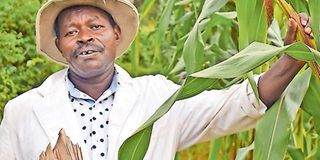Understanding striga and how to curb the weed

Prof Mathew Dida of the Department of Agriculture, Maseno University who has been researching on the striga weed for the last 16 years. PHOTO | ELIZABETH OJINA | NMG
What you need to know:
- Farmers loss 90 per cent to 100 per cent of their yields. It is a threat to food security because it has been resilient over the years.
- It is difficult to control because the seed can hibernate in the soil even if you don’t plant any crop for 20 years.
- There are a number of factors that make the weed prevalent in western Kenya. Natural disasters like floods which are common in western region helps the spread of the weed from one farm to the other.
- The plant does this by producing very little chemical that doesn’t awaken the growth of striga.
Over the years, striga weed has been a threat to food security in the country, affecting mainly the maize crop in western Kenya, where it is prevalent. Elizabeth Ojina spoke to Prof Mathew Dida of the Department of Agriculture, Maseno University who has been researching on the weed for the last 16 years
What is striga and why is it still a threat to food security?
Striga weed (Striga hermonthica) is a parasite plant that affects cereal crops like maize, sorghum or millet. It germinates and attaches itself to the plant’s roots.
The weed sucks all the plant nutrients and minerals it needs for growth. It then poisons the plant, making it stunted.
Farmers loss 90 per cent to 100 per cent of their yields. It is a threat to food security because it has been resilient over the years.
Several technologies have been developed to deal with striga, including push and pull and resistant seeds. Why is the weed still prevalent?
It is a weed which is very special in that it sprouts when farmers have done their weeding. By the time it is germinating, the damage is already done.
It is difficult to control because the seed can hibernate in the soil even if you don’t plant any crop for 20 years.
The weed is prevalent in western Kenya in particular and not in any other areas, why is this the case?
There are a number of factors that make the weed prevalent in western Kenya. Natural disasters like floods which are common in western region helps the spread of the weed from one farm to the other.
Farm implements like ploughs spread the weed because its seeds are tiny, and they will load in the soil. With lack of good control measures over the years, striga has mutated and become difficult to deal with.
You have been researching for years on striga weed resistant maize and millet seeds. What are your findings?
Research has shown that you can fight striga weed through planting seeds that are resistant to the weed. The seeds should have a natural adaptation to fight off the infestation by suppressing the destructive weed.
The plant does this by producing very little chemical that doesn’t awaken the growth of striga. Farmers can double the yield if they plant materials resistant to striga, for instance, planting legumes such as groundnuts, beans suppress the growth of striga weed.
Where can farmers access the seeds you have developed to counter striga?
We are working with Kenya Seed Company to distribute the seeds across the country. Farmers can also look out for counter striga varieties such Maseno EH10, EH11 and EH14 and finger millet variety 60D at the Maseno University.




